Why you can trust Tom's Hardware
Desktop PC Application Benchmarks on Ryzen 9 7900X — the TLDR

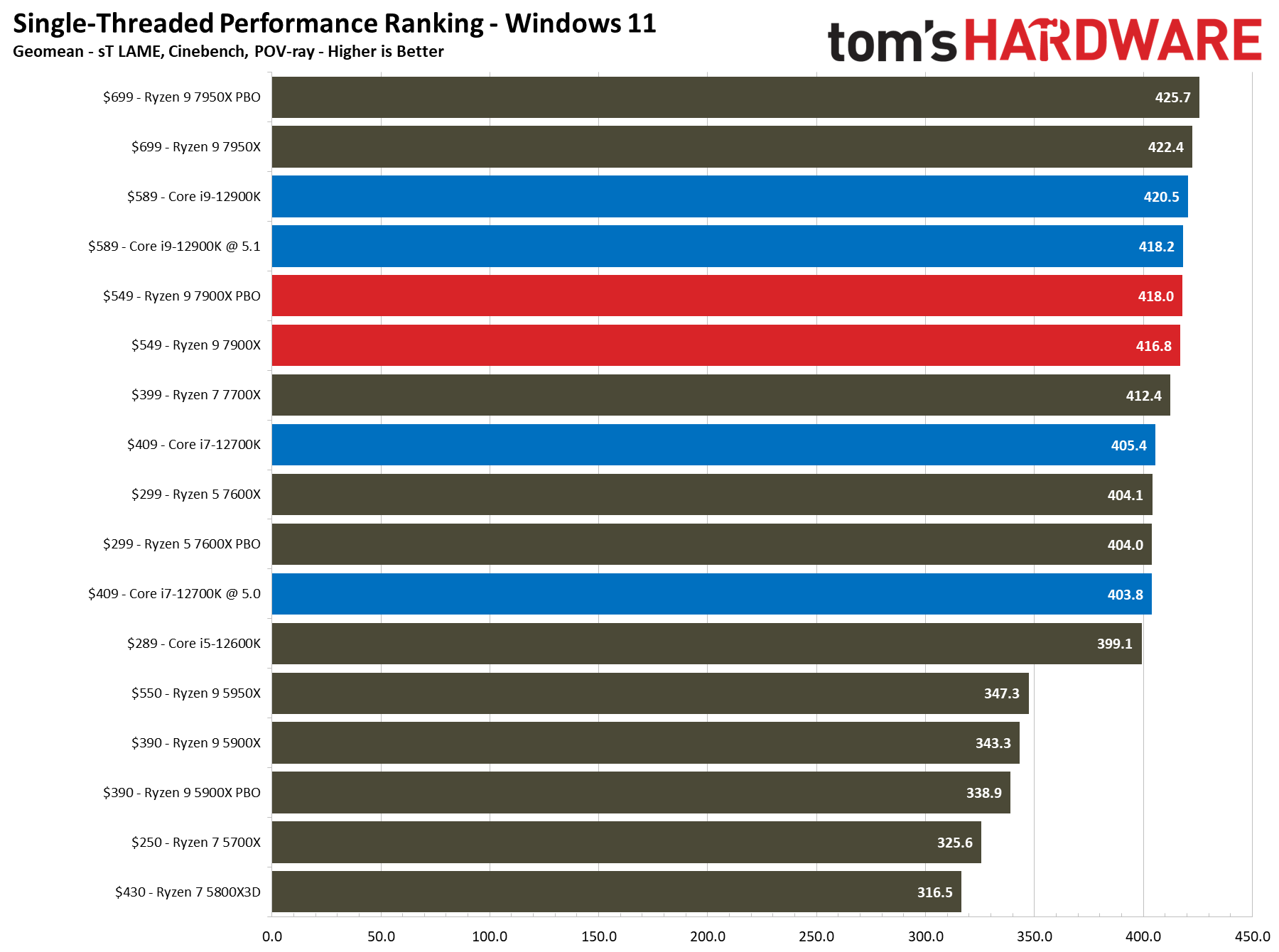
The 16-core Ryzen 9 7950X absolutely dominates our cumulative measurement of multi-threaded performance, but the $549 Ryzen 9 7900X is also impressive, with a 14% lead over the $598 Core i9-12900K. The 7900X is also 35% faster than the previous-gen Ryzen 9 5900X, an impressive gen-on-gen improvement given that both chips have 12 cores.
Intel’s Alder Lake took a pronounced lead in single-threaded performance over the prior-gen Ryzen 5000 processors, but the Zen 4 architecture takes a big step forward, matching or exceeding the price-comparable Alder Lake chips.
You’ll notice that the overclocked configurations offer little to no benefit for the Ryzen processors, as expected, while both Intel processors actually lose some performance in this metric. It isn’t surprising to see the 12900K lose a bit of steam — the all-core 5.1 GHz overclock is lower than its peak 5.2 GHz boosts on a single core — but the 12600K and 12700K’s decline is a bit unexpected because the overclock matches the peak clock rate. After quite a bit of analysis and repeated testing, it appears that thread targeting isn’t working as effectively with the overclocked Intel configurations, resulting in quite a bit of thread migration during single-threaded tasks.
The Ryzen 9 7900X makes a compelling case for creators and prosumers, but high memory and motherboard pricing remain a fly in the ointment. Intel's existing chips are much more competitive on a performance-per-dollar basis when we factor in those costs, and we expect Intel's continued aggressive pricing with Raptor Lake to significantly reduce the appeal of the Ryzen 9 7900X and 7950X at their current pricing. Intel has a pricing advantage with its coming platform, even on a like-for-like basis with DDR5 motherboards. That is amplified with Intel's option for DDR4 platforms.
| Tom's Hardware | Multi-Thread | Single-Thread |
| $699 — Ryzen 9 7950X | 100% | 100% |
| $549 — Ryzen 9 7900X | 79.3% | 98.7% |
| $589 — Core i9-12900K | 69.4% | 99.6% |
| $409 — Core i7-12700K | 59.4% | 96% |
| $399 — Ryzen 7 7700X | 57.2% | 97.6% |
| $299 — Ryzen 5 7600X | 45.1% | 95.7% |
| $430 — Ryzen 7 5800X3D | 41.7% | 74.9% |
Rendering Benchmarks on AMD Ryzen 9 7900X





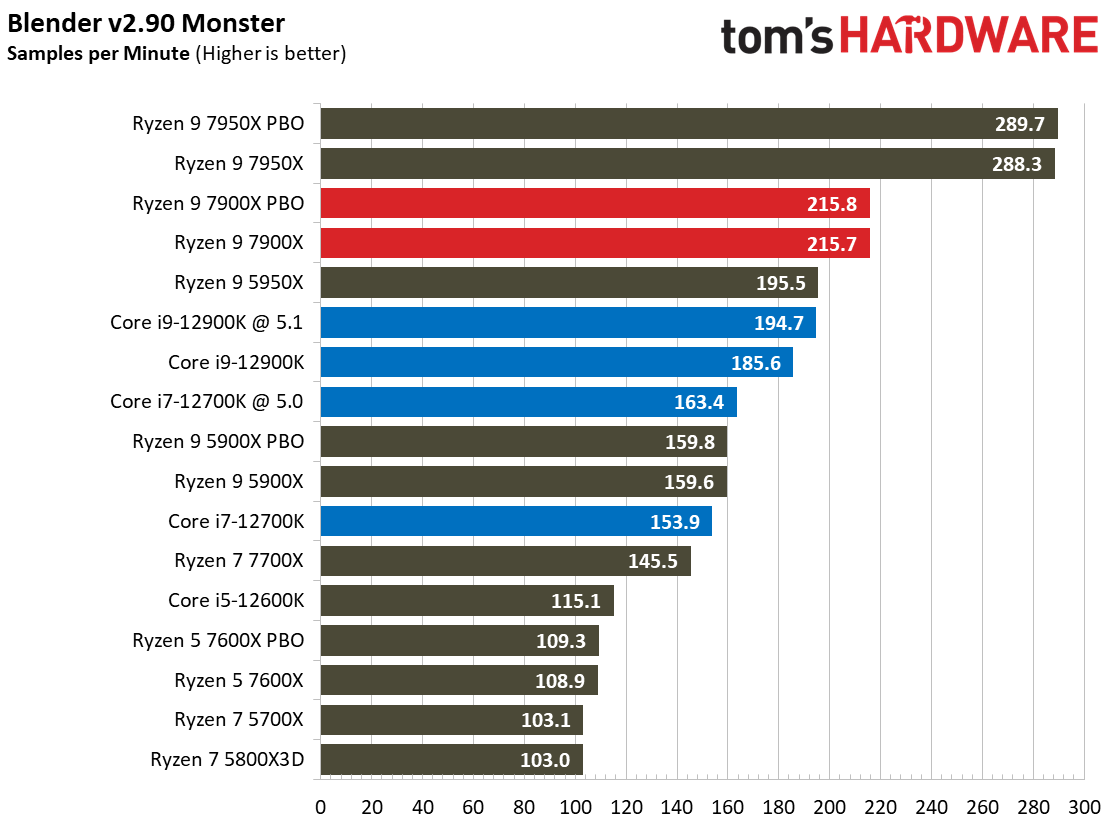


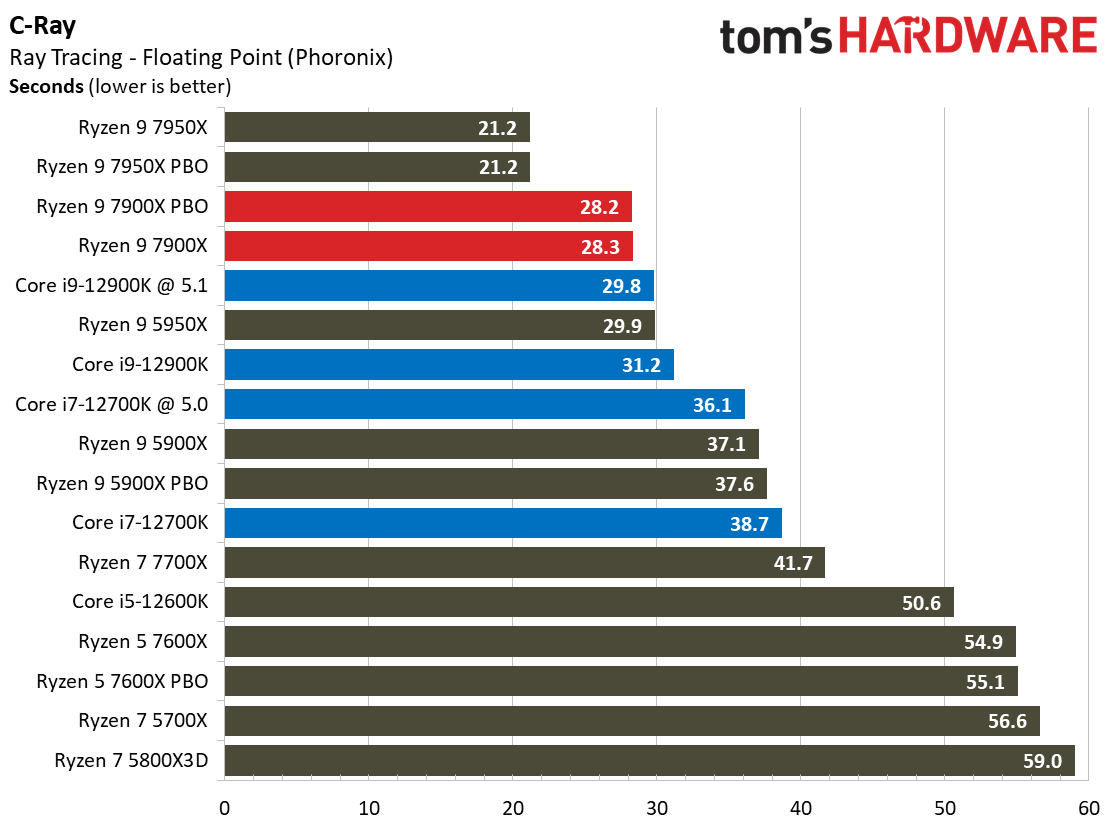

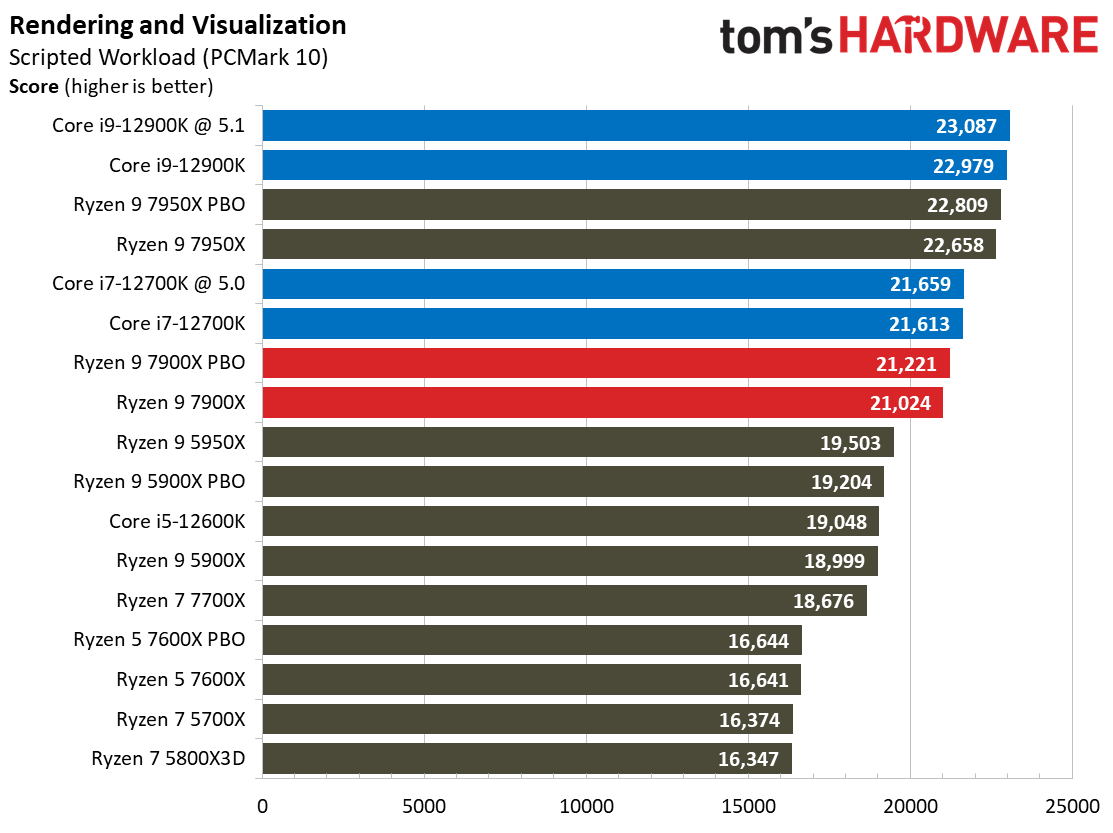
It was initially surprising to see Alder Lake’s hybrid architecture largely beat Ryzen in threaded workloads after AMD had dominated these types of benchmarks for years. The Ryzen 9 7950X quashed that uprising on the high end — at least until Raptor Lake arrives — but the Ryzen 9 7900X vs Core i9-12900K battle isn't quite as clear cut in some benchmarks.
For instance, the Ryzen 9 7950X is 5% faster than the 12900K in the multi-threaded Cinebench benchmarks, but the 12900K is 11% faster in POV-Ray. The Ryzen 9 7900X leads in the Blender renders, being 16% to 23% faster than the 12900K. Overclocking the Intel chip isn’t enough to change the picture, either.
Encoding Benchmarks on AMD Ryzen 9 7900X



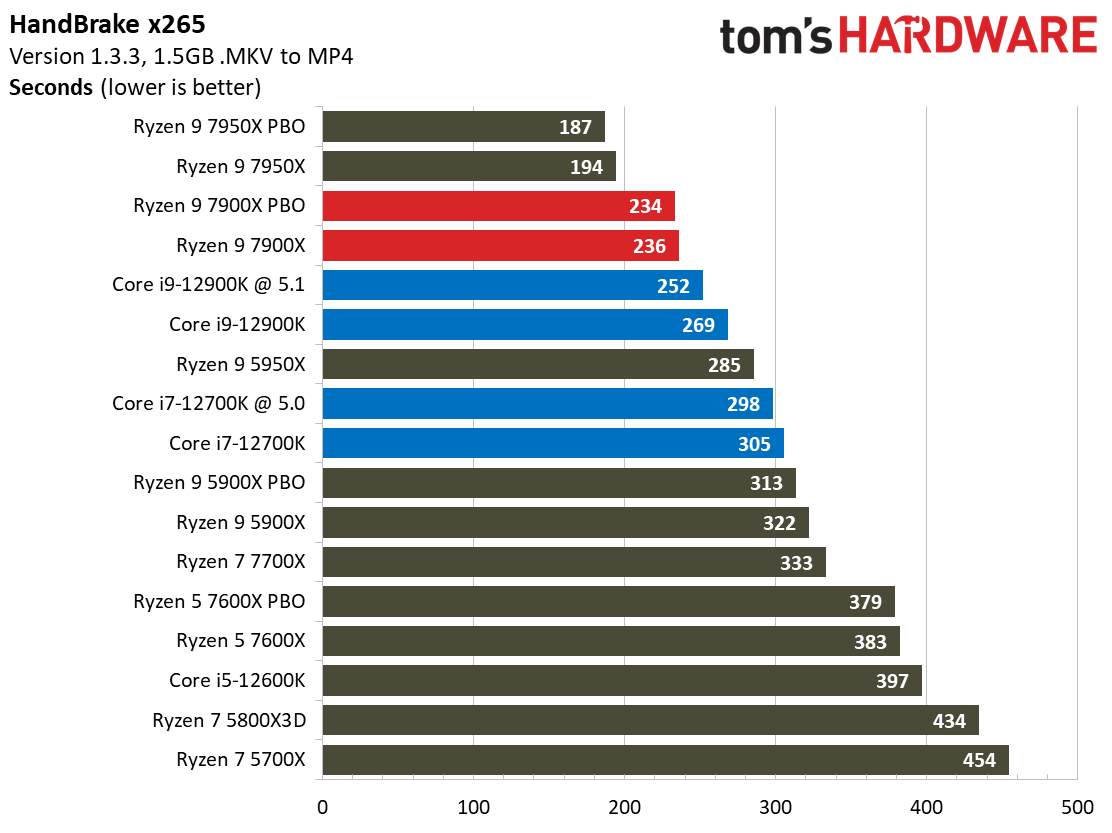






Most encoders tend to be either heavily threaded, like HandBrake and SVT-AV1, or almost exclusively single-threaded, like the LAME and FLAC applications. The Ryzen 7900X leads the Core i9-12900K in both types of applications, sweeping this series of tests, though often not by large margins.
Get Tom's Hardware's best news and in-depth reviews, straight to your inbox.
Adobe Premiere Pro, Photoshop and Lightroom on AMD Ryzen 9 7900X



The UL Benchmarks Procyon suite runs complex Adobe Premiere Pro, Photoshop, and Lightroom workflows with the actual software, making for a great real-world test suite. The Ryzen 9 7900X beats Alder Lake handily in Premiere Pro and the Lightroom and Photoshop benchmarks.
Web Browsing, Office and Productivity on AMD Ryzen 9 7900X


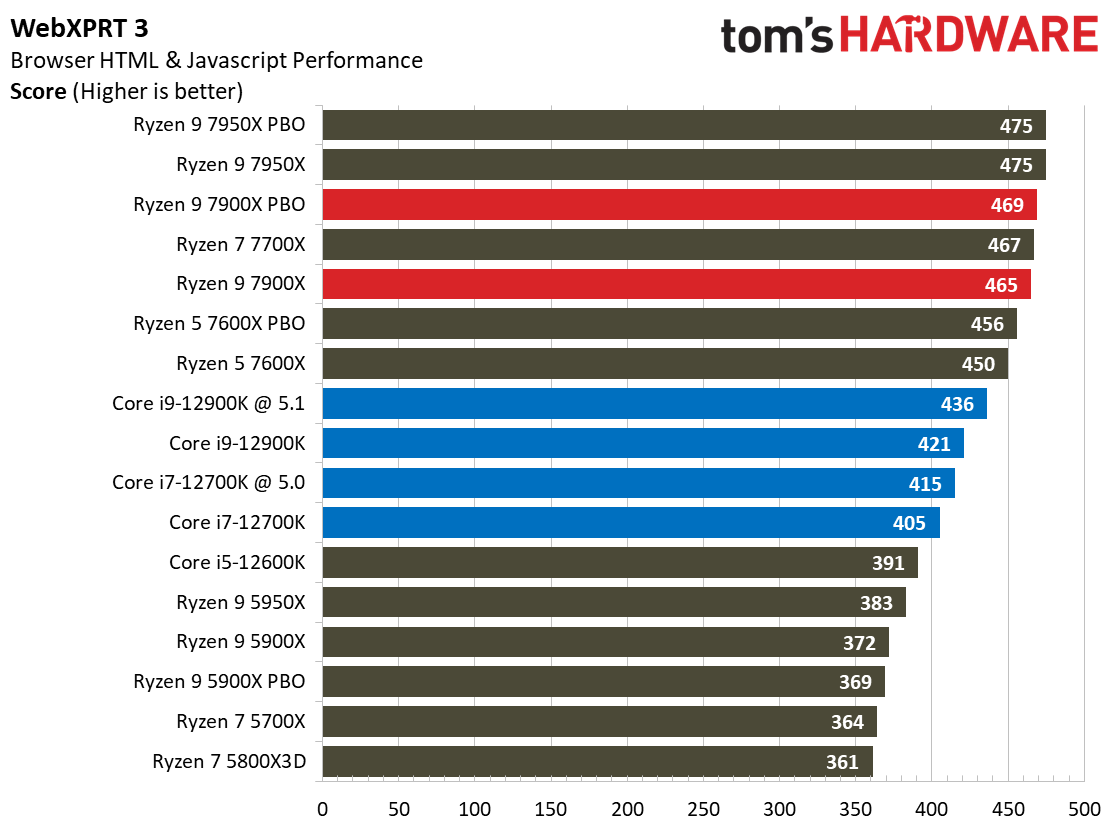
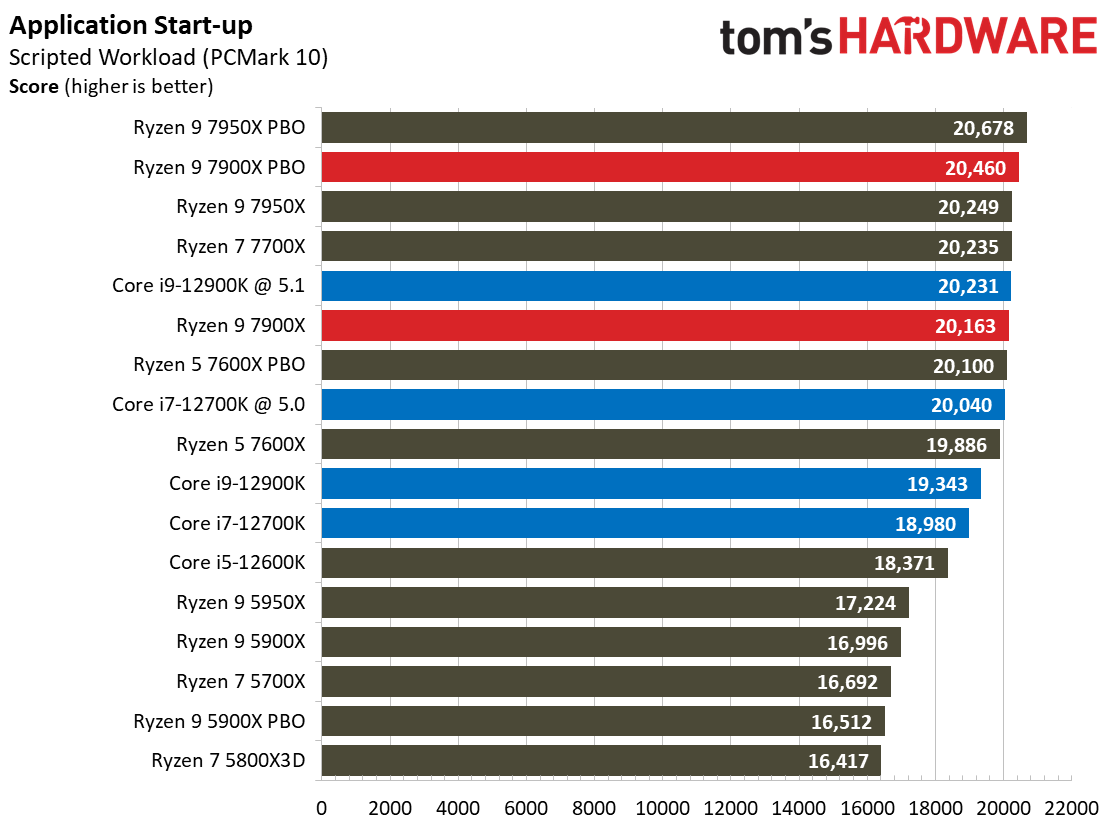

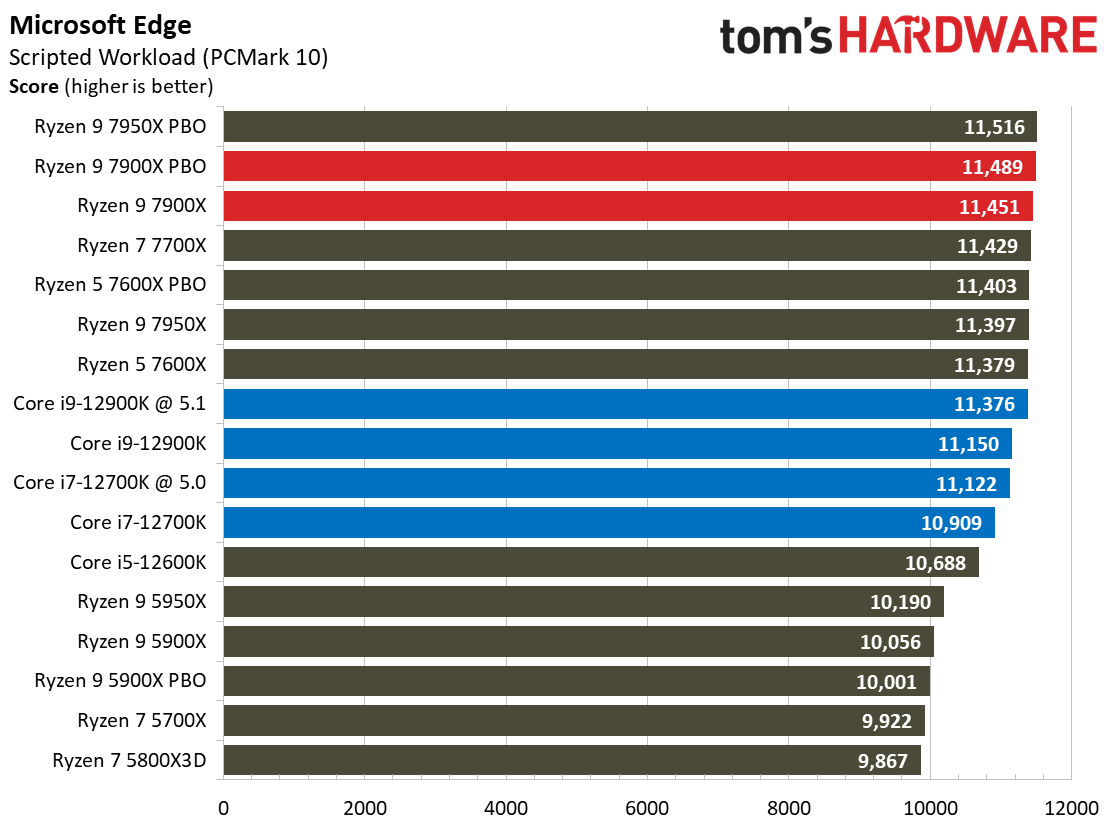
The ubiquitous web browser is one of the most frequently used applications. These latency-sensitive tests tend to be lightly threaded, so a fast response time is critical. Intel typically dominated these benchmarks, but Ryzen 7000 flips the tables and takes the lead in every browser test. AMD has also improved its standing in the Application Start-up benchmark, which compares how long it takes to open various applications and is a great measure of system snappiness.
Compilation, Compression, AVX-512 Performance on AMD Ryzen 9 7900X



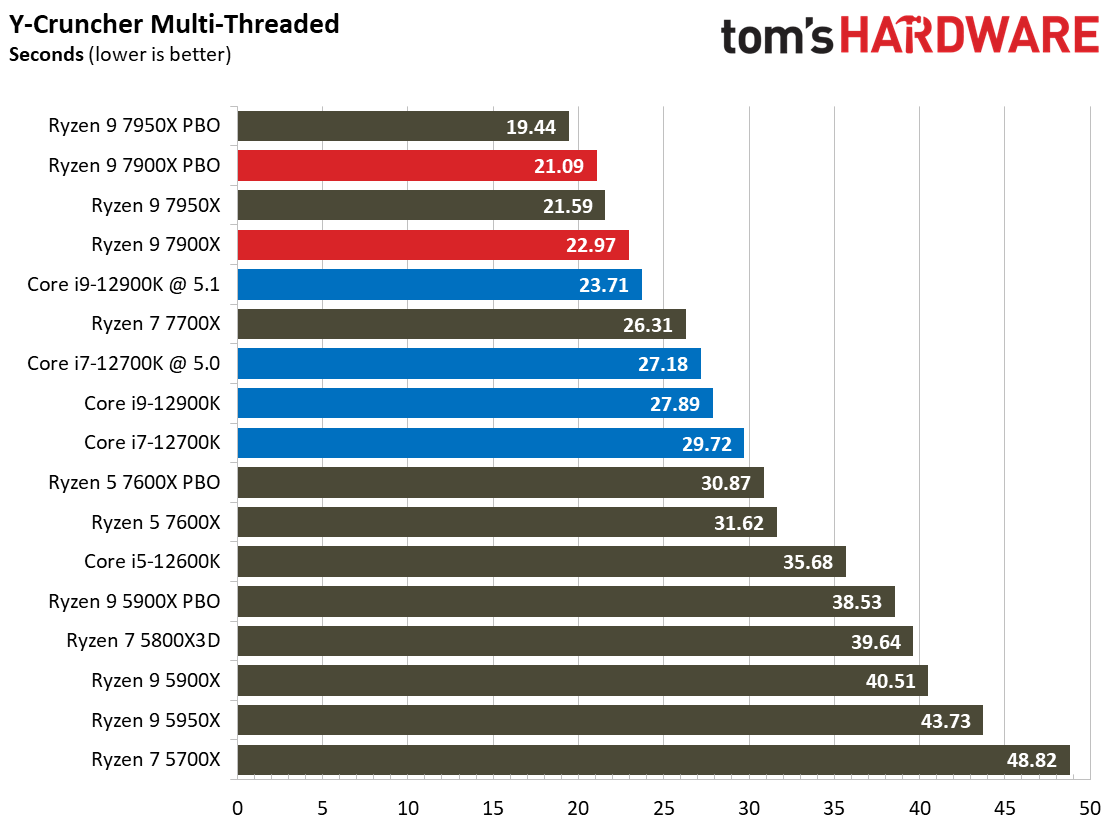

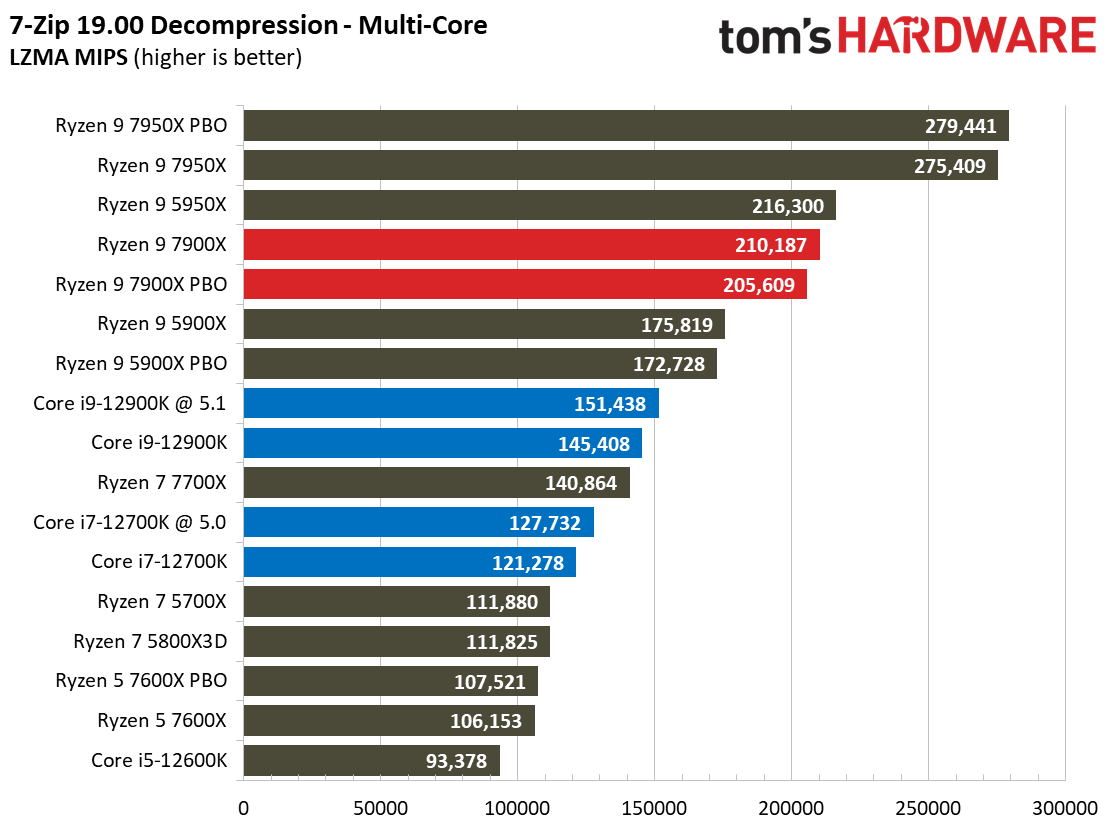








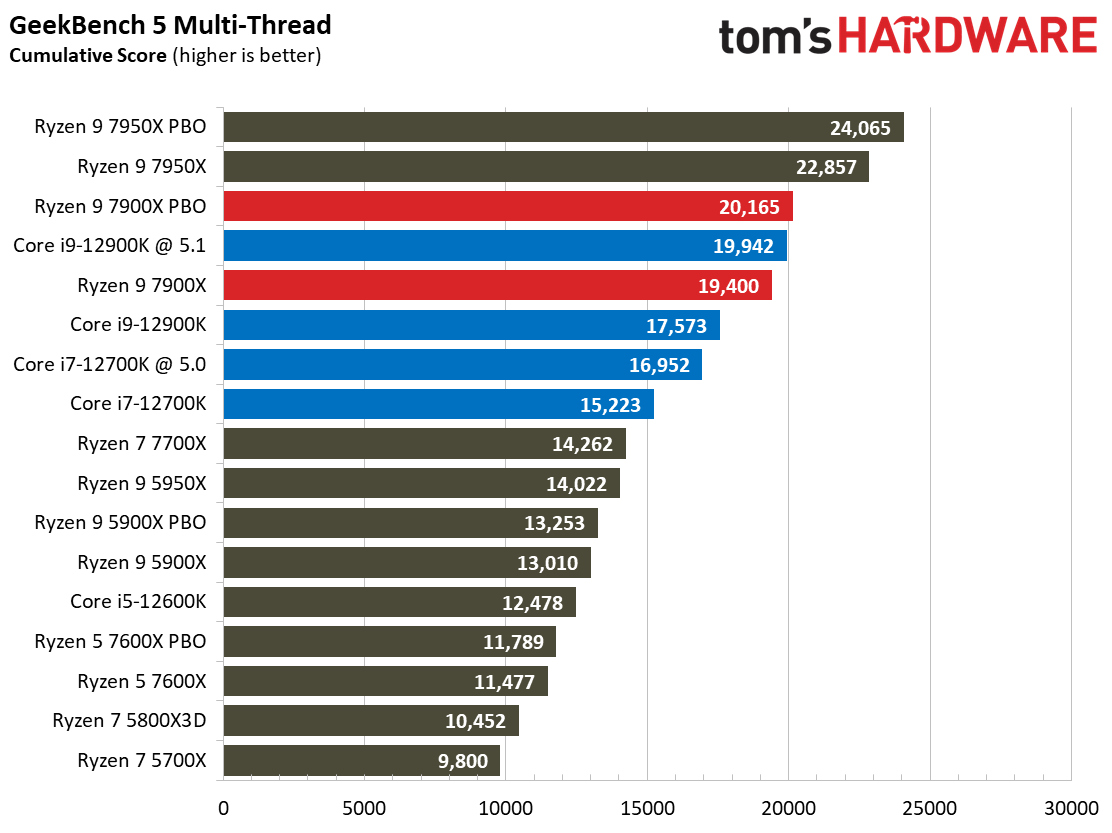
This selection of tests runs the gamut from the exceedingly branchy code in the LLVM compilation workload to the massively parallel molecular dynamics simulation code in NAMD to encryption and compression/decompression performance.
Y-cruncher computes Pi with the AVX instruction set, making for an exceedingly demanding benchmark. We employed the latest version of y-cruncher that has added support for Zen 4, and here we can see the benefits of AVX-512 become apparent in the single-threaded benchmark. Spreading the workload out among the cores in the threaded portion of the y-cruncher test reduces the magnitude of the lead over Intel (per-core memory throughput and/or fabric throughput are likely barriers here), but the Ryzen 9 7900X leads over Alder Lake. The generational performance improvement is also readily apparent compared to the Ryzen 9 5900X.
Ryzen has long had an uneven performance in compression/decompression workloads, with decompression being a strength while compression suffered compared to other chips. The Zen 4 architecture delivers impressive performance in both workloads, reducing the disparities.
- MORE: AMD vs Intel
- MORE: Zen 4 Ryzen 7000 All We Know
- MORE: Raptor Lake All We Know
Current page: Desktop PC Application Benchmarks on Ryzen 9 7900X
Prev Page Gaming Benchmarks AMD Ryzen 9 7900X Next Page Conclusion
Paul Alcorn is the Editor-in-Chief for Tom's Hardware US. He also writes news and reviews on CPUs, storage, and enterprise hardware.
-
chalabam The charts are hard to read. The fonts are too small, and the lines and dashes are very difficult to tell apart.Reply -
ddcservices Yet more nonsense in a supposedly unbiased review. Motherboards aren't really all that much more expensive than what came out for previous generations, outside of the boards that have far too many features or just add things that will cost a lot. PCI Express 5.0 support for example...a single PCIe 5.0 M.2 slot would be normal, and you will get it from all of the AM5 motherboards. Add a x16 slot with PCIe 5.0, and that adds to the prices.Reply
So, beyond this, boards like the Asus x670e Hero for $700...three M.2 slots with PCIe 5.0 speeds, the number of ports, this and that...yep, excessive, but the number of PCIe 5.0 slots are going to do that, along with Asus just charging a lot. The ASRock boards are NOT overpriced, and many of the other motherboards aren't overpriced really. So, no reason to complain about prices.
DDR5...$70 more than good DDR4 memory, compare the price of DDR4-3600 to DDR5-6000, yea, a bit of a price premium for DDR5, but it's new, and DDR5 prices are NOT really horrible. So, "pricing problem" seems to be more about an Intel bias, because other than, "it's new and hasn't been discounted". The pure gaming performance people will be happy with older AM4 for this generation and the Ryzen 7 5800X3D, but for those who do more than play games, honestly, motherboard+CPU+RAM all at the same time, CPU prices are NOT at a premium compared to previous generations, motherboards are generally at a comparable price, outside of a lack of cheap/low end boards that have no features, and B650 will cover that for the most part. RAM, don't compare DDR4-3000 to DDR5-6000 for price, because that's not a fair comparison. As I said, G.skill Trident Z5 Neo 6000CL30 vs. DDR4-3600CL14, what's the real price difference? Not really enough to complain about.
I may be biased, but not pointing out how Intel boards with similar features and on DDR5(not the cheaper DDR4 versions) are only cheaper because Intel is willing to give away chipsets at this point. -
TechieTwo According to reviews from those building AM5 systems the performance and value is fine from those not buying the extortion model mobos.Reply -
PlaneInTheSky ReplyYet more nonsense in a supposedly unbiased review. Motherboards aren't really all that much more expensive than what came out for previous generations
uhm, yes they are
The motherboards are a lot more expensive in nominal terms. Add in the depreciation of many currencies, and these AMD motherboards are extremely expensive. Add in the cost of DDR5.
The result is an outrageously expensive Zen 4 platform that doesn't even perform that well in games.
Zen 4 is going to need a massive price cut when Raptor lake arrives in a few days. Price / performance, Zen 4 is a disaster. The review is spot on. -
PlaneInTheSky ReplyDDR5 prices are NOT really horrible
Yes they are. Regardless, you have to buy new memory. It's not just about how much more DDR5 costs compared to DDR4, it's about needing to throw away DDR4 because AMD had the bright idea that dropping DDR4 compatbility was a smart move. This foolish decision is going to cost them a lot in sales. -
fybyfyby Reply
I agree with some of your statements. I bought new platform and it was worth it. But if I compare prices, DDR5 6000 EXPO costs nearly double the DDR4. Motherboard - ASUS B650 - E costs 9500 CZK and AM4 version (B550 - E) cost me 6500 CZK - but I didnt buy it at the start of the chipset. It was during the chipset lifetime. anyway, its more expensive. It may be due to PCIex5 added cost, I dont know. Also, DDR5 are new. Every gen, new DDR memories are "expensive".ddcservices said:Yet more nonsense in a supposedly unbiased review. Motherboards aren't really all that much more expensive than what came out for previous generations, outside of the boards that have far too many features or just add things that will cost a lot. PCI Express 5.0 support for example...a single PCIe 5.0 M.2 slot would be normal, and you will get it from all of the AM5 motherboards. Add a x16 slot with PCIe 5.0, and that adds to the prices.
So, beyond this, boards like the Asus x670e Hero for $700...three M.2 slots with PCIe 5.0 speeds, the number of ports, this and that...yep, excessive, but the number of PCIe 5.0 slots are going to do that, along with Asus just charging a lot. The ASRock boards are NOT overpriced, and many of the other motherboards aren't overpriced really. So, no reason to complain about prices.
DDR5...$70 more than good DDR4 memory, compare the price of DDR4-3600 to DDR5-6000, yea, a bit of a price premium for DDR5, but it's new, and DDR5 prices are NOT really horrible. So, "pricing problem" seems to be more about an Intel bias, because other than, "it's new and hasn't been discounted". The pure gaming performance people will be happy with older AM4 for this generation and the Ryzen 7 5800X3D, but for those who do more than play games, honestly, motherboard+CPU+RAM all at the same time, CPU prices are NOT at a premium compared to previous generations, motherboards are generally at a comparable price, outside of a lack of cheap/low end boards that have no features, and B650 will cover that for the most part. RAM, don't compare DDR4-3000 to DDR5-6000 for price, because that's not a fair comparison. As I said, G.skill Trident Z5 Neo 6000CL30 vs. DDR4-3600CL14, what's the real price difference? Not really enough to complain about.
I may be biased, but not pointing out how Intel boards with similar features and on DDR5(not the cheaper DDR4 versions) are only cheaper because Intel is willing to give away chipsets at this point.
So nothing to whine about. CPUs are great and if for someone AM5 is expensive, he or she can buy AM4 and it will last several years without a problem. -
somebassplayer The "pricing problem" is early adopter tax. People who want to be the first on their block to get onto 7xxxx series should expect to pay high(er) prices. The rest of us will wait until prices come down beforeReply
upgrading. -
ikernelpro4 Reply
I don't know about you but AM4 compatibility would've been clever to at least get more people / "early adopters".somebassplayer said:The "pricing problem" is early adopter tax. People who want to be the first on their block to get onto 7xxxx series should expect to pay high(er) prices. The rest of us will wait until prices come down before
upgrading.
100%. A lot of folks bought fast, perhaps even premium, DDR4 RAM in the past year or two, especially during the crazy-price pandemic.PlaneInTheSky said:Yes they are. Regardless, you have to buy new memory. It's not just about how much more DDR5 costs compared to DDR4, it's about needing to throw away DDR4 because AMD had the bright idea that dropping DDR4 compatbility was a smart move. This foolish decision is going to cost them a lot in sales.
I bought DDR4 3200 RAM and I do not plan to upgrade any time soon regardless what chip manufacturers present.
AMD simply bet on the wrong horse.
This is not a new platform that people who want to build complete new systems will fall onto, the price is not allowing that.
DDR5 is fast but you know what's also BLAZING fast? DDR4. Especially +3200 MHz. This is not a noticeble, jump like you PC unfreezes or suddenly memory intensive operations run like a night-day difference.
We have reached a point where "old" aka current hardware is so fast, that even many(!) years from now, they'll be fast and viable enough to substain.
This is not a jump from 5MB of DDR2 RAM to 16GB DDR4, this isn't a completely new platform. There's no incentive. -
Pyrostemplar ReplyPlaneInTheSky said:uhm, yes they are
The motherboards are a lot more expensive in nominal terms. Add in the depreciation of many currencies, and these AMD motherboards are extremely expensive. Add in the cost of DDR5.
The result is an outrageously expensive Zen 4 platform that doesn't even perform that well in games.
Zen 4 is going to need a massive price cut when Raptor lake arrives in a few days. Price / performance, Zen 4 is a disaster. The review is spot on.
No, it is a rather poor review, as it bases most (if not all) of its conclusion on the price of other components. In itself it wouldn't unreasonable if there was anything structurally definitive about the price of those said components: e.g. 4 channel server class motherboards. But no, AM5 mobos and DDR5 are the mainstream solutions going forward, so this review - and its conclusion - will age really badly.
AM5 X670E motherboards are already available under 300USD, and DDR5 is dropping price by the day. They won't go under DDR4 solutions pricing, but with inflation as it is, that is not really surprising, is it?
Zen 4 itself doesn't need a price cut unless Raptor outperforms its price/performance. If it does, then price cuts will be forthcoming - all the better for me :) -
cirdecus This is really not a good review. You don't knock off two stars for a product that is an excellent performer, priced well and uses the latest platform and technology. If you're upset that DD5 and AM5 costs a lot of money, that's a completely different article.Reply
Also, every new technology has come with a cost premium. Right now, you're intersecting a new socket, with new RAM technology and new PCI 5.0 tech all into one upgrade cycle. I don't care whether you go with an Intel platform or AMD platform, you're paying a lot for DD5, regardless. If you downgrade to DDR4, great, you can go with intel.
Complaining that DDR 5200 (6000 is actually what AMD recommends) is only supported by one channel and filling out the banks with 4 sticks drops the speed, is a relatively decent complaint. However, it's half a star at best. You're not going to win an argument that people need more than 64GB of highspeed memory in a system like this. If you need more, then this isn't the right platform. Users should be steered towards AMD's HEDT Thread-rippers. Mainstream processors simply don't need more than 64GB of memory. That's the equivalent of knocking an automobile manufacturer for not offering a 15000lbs towing capacity for their mid-sized trucks.